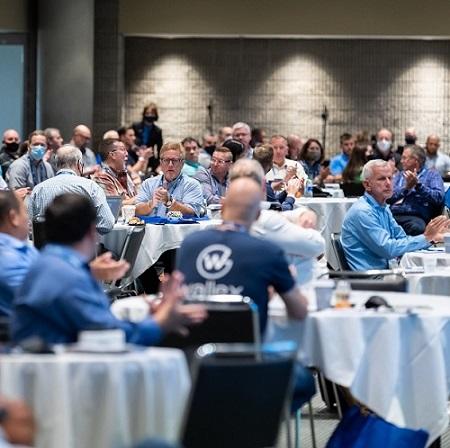165 glass industry representatives gathered at the Glazing Executives Forum, Sept. 13 in Atlanta, to discuss some of the top challenges facing glazing firms today, from the ongoing labor shortage to risk management, and from market uncertainty to lingering supply chain difficulties. The Glazing Executives Forum, now in its 15th year, is organized by the National Glass Association and held in conjunction with GlassBuild America.
4 TOP TAKEAWAYS FROM THE FORUM
1. LABOR SHORTAGE CONTINUES TO BE TOP CONCERN FOR GLAZIERS
“The biggest issue facing glaziers today is the labor shortage,” says Jenni Chase, director of content and education for the NGA.
The overall construction industry lost 1.1 million jobs in the first two months of the pandemic, adding to an already difficult labor situation for construction firms, says Ken Simonson, chief economist of the Associated General Contractors of America, who delivered the morning keynote address during the Forum. While residential construction employment rebounded and has actually reached above February 2020 levels, nonresidential continues to struggle. “It’s way behind where it was in February 2020 with over 200,000 jobs less,” Simonson says.
The most difficult positions to fill are craft positions, he says. “Glaziers are among those craft positions, and over 70 percent say have trouble filling jobs,” Simonson says.
2. BUILD A STRONG COMPANY CULTURE TO RETAIN WORKERS
Speakers during the Personnel Issues Roundtable panel discussion said a strong company culture with employee-focused management and incentives is necessary to keep workers. The panel, moderated by NGA’s Chase, included Brady Nails, regional manager, Binswanger Glass; Gregory Wright, director of operations, Giroux Glass; and Kyle Sharp, CEO, Sharp Glass.
While fair compensation is necessary to keep people, the panelists discussed other incentives and rewards to help build a strong company culture and increase loyalty among employees. Some ideas include tuition reimbursement, unlimited paid time off and flexible scheduling. Additionally, panelists say that instilling a sense of ownership among employees goes a long way to building a strong culture.
“We are recruiting younger and younger people. So, we are focused on how to build ownership among those workers, allowing for ownership in decision making, getting feedback, having team meetings,” says Nails.
3. SUPPLY CHAIN WOES TO CONTINUE; COMMUNICATION CAN HELP
The pandemic upended global supply chains, leading to delays and material cost inflation. During the Forum, AGC’s Simonson described the ripple effect of supply chain delays, which could continue for the remainder of the year. “Unfortunately, the supply chain problems do look like they’re going to continue,” he says. “When ships start coming, they are coming too fast for West Coast ports to handle. Why? Because the terminals are stacked so high with containers. Why? Because there aren’t enough truck drivers. … There are a lot more bottlenecks for construction.”
Simonson emphasized the importance of communication among construction project team players. “Let a contractor know if you’re not going to be able to supply on time or with the quantity needed. Put that information in your documents,” he says. The AGC developed a Construction Inflation Alert, with supporting documents and resources to help communicate the ongoing supply and pricing challenges to owners and officials. It is available at agc.org.
4. RISK MANAGEMENT BECOMES INCREASINGLY IMPORTANT WITH DESIGN ASSIST
To protect their glazing companies, owners need to establish risk management practices on every project, according to panelists during the session Project Best Practices to Avoid Legal Headaches. Presenters David Ben-Israel, project, cost and construction management consultant at MGAC, and John Nolan, practicing attorney at The Gary Law Group, noted that the move to design assist and delegated design project delivery methods puts additional legal risk on glazing contractors. “Any kind of design work is potentially problematic,” says Nolan. “It’s much easier to just say, ‘here’s my work, this is what I do.’ Once you start to get into design aspects, you’re going to start to get into further risk issues.”
Ben-Israel recommends glaziers develop a risk management process for every project before submitting a bid. “On any given project, get your project manager, sit down and come up with risks for that job. Then prioritize those risks and develop mitigation strategies,” says Ben-Israel. From that, company leaders can determine if a project has too many downside risks to move forward with a bid. Or, if they do move forward with a bid, they can prepare and plan mitigation strategies from the start.
